|
COLUMBIA TRISTAR
|
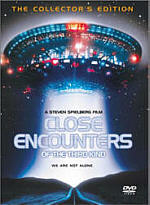
| |
|
MOVIE INFO
|
Director: Steven Spielberg
Cast: Richard Dreyfuss, Francois Truffaut, Teri Garr, Melinda Dillon, Bob Balaban, J. Patrick McNamara, Warren J. Kemmerling
Screenplay: Steven Spielberg
Tagline: We are not alone.
MPAA: Rated PG for some intense sci-fi action, mild language and thematic elements.
Academy Awards:
Won for Best Cinematography.
Nominated for Best Picture; Best Director; Best Supporting Actress-Melinda Dillon; Best Art Direction-Set Decoration; Best Visual Effects; Best Film Editing; Best Sound; Best Score-John Williams.
| |
|
DVD DETAILS
|
Presentation:
Widescreen 2.35:1/16x9
Audio:
English Dolby Digital 5.1
English DTS 5.1
English Dolby Surround
French Digital Stereo
Spanish Digital Stereo
Subtitles: English, Spanish, French, Portuguese, Chinese, Korean, Thai
Closed-captioned
Runtime: 137 min.
Price: $27.95
Release Date: 5/29/2001
Bonus:
• “The Making of Close Encounters of the Third Kind” Documentary
• 11 Deleted Scenes
• Original 1977 Featurette “Watching the Skies”
• Theatrical Trailers
• Filmographies
• Production Notes
| |
|
EQUIPMENT
|
Sony 36" WEGA KV-36FS12 Monitor; Sony DA333ES Processor/Receiver; Panasonic CV-50 DVD Player using component outputs; Michael Green Revolution Cinema 6i Speakers (all five); Sony SA-WM40 Subwoofer.
| |
[an error occurred while processing this directive]
|
Close Encounters of the Third Kind (1977)
|
|
Reviewed by Colin Jacobson
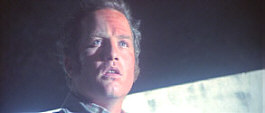 In an odd way, Close Encounters of the Third Kind had a profound effect on my life. That’s because the movie’s existence indirectly led to my relationship with my long-time best friend Kevin.
In an odd way, Close Encounters of the Third Kind had a profound effect on my life. That’s because the movie’s existence indirectly led to my relationship with my long-time best friend Kevin.
Although Kevin and I had known each other since he moved to our area in the summer of 1975, we’d never been friends. Kevin joined the Cub Scout “den” my Mom started at that time, so we hung out together to some degree, but no friendship formed until the winter of 1977. While we were in fifth grade, Kevin and another classmate, Jeff Leibowitz, produced a couple of issues of Splash Magazine, a Xeroxed effort with some cute little articles and other bits and pieces. Frankly, I don’t recall much about the content of Splash, but it seemed cool to the rest of us.
When it came time to produce the third issue of Splash, Close Encounters of the Third Kind was the hot movie, so Kevin and Jeff wanted to do a “cover story” about it. Since I happened to own the paperback novelization of the story, I volunteered to draw a copy of the movie’s poster art for the cover of the magazine. Thus my closer relationship with Kevin was born, and although we never did produce that third issue of Splash, we’ve been friends ever since.
As with virtually any relationship, Kevin and I have endured some rocky moments over the past 23-plus years, and I’ve also had my ups and downs with Close Encounters itself. I loved the movie at the time of its release, as did all of us kids. With both Star Wars and CE3K, 1977 was a killer year for science fiction, and we were happy to digest all of it.
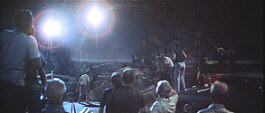 However, I took something of a disliking to CE3K in later years. I’m not terribly sure why this was, but it actually likely showed the influence of the original aspect ratio. I’ve never been an OAR zealot - if someone enjoys cropped films, that’s their prerogative, and I’m not going to tell someone what they can and can’t like - but I’ve been a strong supporter of properly-framed movies for quite some time. Honestly, the main reason I got into laserdisc in 1991 wasn’t because of supplements or the improved quality offered by the format; those were nice, but I really just wanted to be able to see movies in their correct dimensions.
However, I took something of a disliking to CE3K in later years. I’m not terribly sure why this was, but it actually likely showed the influence of the original aspect ratio. I’ve never been an OAR zealot - if someone enjoys cropped films, that’s their prerogative, and I’m not going to tell someone what they can and can’t like - but I’ve been a strong supporter of properly-framed movies for quite some time. Honestly, the main reason I got into laserdisc in 1991 wasn’t because of supplements or the improved quality offered by the format; those were nice, but I really just wanted to be able to see movies in their correct dimensions.
Until I delved into LD, I’d not had as strong a grasp on the benefits of OAR reproduction, but I knew that quite a few movies I used to enjoy didn’t work for me on cropped VHS. Not coincidentally, most of these flicks had originally appeared as 2.35:1 presentations. This wasn’t a perfect rule, as I’d had no serious problems watching widescreen films like Ghostbusters or Raiders of the Lost Ark in their pan and scan cuts; obviously, I prefer them in their original ratios, but when I watched both on tape as a teenager, I still really liked them.
However, many movies lost their luster. Although I’d loved movies like Alien, Die Hard, Jaws and CE3K theatrically, their VHS replications left me cold. Only when I saw these flicks properly framed on LD was I once again able to rediscover their charms. All of the above-mentioned movies and a number of others regained their prior status with me once I was able to view the entire picture.
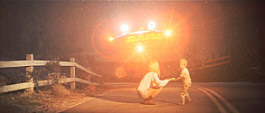 CE3 probably took the biggest jump of that bunch because it was the only one I’d actually come to dislike over the years. In retrospect, my opinion of the film had dropped so much that I’m not sure why I pursued it on LD. Perhaps it was the allure of the Criterion Collection’s deluxe boxed set with its copious extras, but I decided to take the plunge in the summer of 1992.
CE3 probably took the biggest jump of that bunch because it was the only one I’d actually come to dislike over the years. In retrospect, my opinion of the film had dropped so much that I’m not sure why I pursued it on LD. Perhaps it was the allure of the Criterion Collection’s deluxe boxed set with its copious extras, but I decided to take the plunge in the summer of 1992.
To put it mildly, I’m glad I did. In addition to the supplements and the original aspect ratio, however, the Criterion release held an additional appealing element: different cuts of the film. Two versions of CE3K have been widely seen by the public. There’s the original 132-minute edition that first hit screens in 1977; that’s the one I loved as a kid. However, director/writer Steven Spielberg wasn’t able to fully realize all of the shots he’d wanted for the film.
As such, in 1980 he produced the 135-minute “Special Edition” version of CE3K. Although this cut added new footage, it was a shorter film due to some judicious editing on the part of Spielberg; he cut 16 minutes of shots from the original, reinstated seven minutes of material filmed in 1977 but not used, and added six minutes of newly-made material.
The latter entries included the most controversial one: scenes from inside the Mothership at the end of the film. To get funding for the reshoot, Columbia wanted Spielberg to add these segments. As such, the SE of CE3K was a rather different film than the one originally seen in 1977.
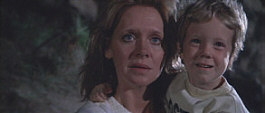 As far as I know, the original cut of CE3K only appeared on home video via the Criterion LD releases and was never available on VHS. The CLV Criterion LD provided only the 1977 edition, while the CAV set allowed the viewer to watch either the 1977 or 1980 versions or some user-defined combination of the two.
As far as I know, the original cut of CE3K only appeared on home video via the Criterion LD releases and was never available on VHS. The CLV Criterion LD provided only the 1977 edition, while the CAV set allowed the viewer to watch either the 1977 or 1980 versions or some user-defined combination of the two.
Before I got the CAV package, I’d only seen the 1980 version since 1978, and I think that cut’s largely responsible for my subsequent dissatisfaction with CE3K. I missed a lot of the shots from the original that disappeared in the new cut - such as Roy’s continued disintegration and the military press conference - and I simply loathed the ending footage inside the Mothership. The 1977 edition ended in such a lovely and touching manner, and the new material totally disrupted the tone. Those scenes should never have made it onto the screen.
Happily, the DVD release of CE3K restores the film to its original ending, although we don’t get the 1977 cut of the movie. Instead, the DVD provides a third edition of the flick, one created by Spielberg for a 1998 VHS and LD release. This 137-minute “Collector’s Edition” cut combines different aspects of the 1977 and 1980 versions. Many think this is the best edition of the movie, and I can’t say I disagree, but some good bits from the 1977 film fail to appear. The introduction to the Nearys uses the scene from the 1980 cut, which is more abrupt but it adds some nice exposition to the family, so I prefer it. Other 1980 snippets are integrated, such as “Roy’s shower” and the expedition to the Gobi Desert.
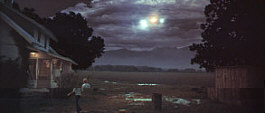 The 1998 version cuts some segments that appeared in both the 1977 and 1980 versions, and these are the least positive changes. We lose the cool scene in which Roy looks at a pillowcase and states, “That’s not right”. We also don’t get some shots of Roy at the power plant; I liked these, but I can’t say they’re as painful to lose as the pillowcase. The alterations don’t hurt the movie terribly, but I wish Spielberg had kept these scenes in the movie.
The 1998 version cuts some segments that appeared in both the 1977 and 1980 versions, and these are the least positive changes. We lose the cool scene in which Roy looks at a pillowcase and states, “That’s not right”. We also don’t get some shots of Roy at the power plant; I liked these, but I can’t say they’re as painful to lose as the pillowcase. The alterations don’t hurt the movie terribly, but I wish Spielberg had kept these scenes in the movie.
Nonetheless, the 1998 form of the movie certainly should still remind long-time fans why they love the flick. At its heart, CE3K is a simple fantasy that depicts the first formal meeting of humans and aliens. Although the film certainly features the global point of view and shows how governments might respond to this event, Spielberg wisely took the more intimate approach to tell the story.
Roy Neary (Richard Dreyfuss) works as a technician for an Indiana power company and lives with his wife Ronnie (Teri Garr) and three kids. He seems like a nice enough guy, but clearly the bloom is off the rose and he’s living a fairly drab existence. All of that changes when some force causes electricity to cut off all across his area. After he’s sent to work on the situation, he comes quite close to some alien vehicles, and the experience leaves him changed, to say the least. From then on, he feels a nagging urge to find meaning in odd shapes, a desire that eventually leads him to apparent semi-madness.
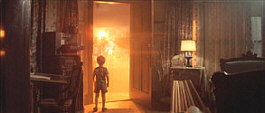 However, that’s not the case, and before too long Neary and others - including Jillian Guiler (Melinda Dillon), whose son Barry (Cary Guffey) has been kidnapped by the aliens - figure out what it is they need to do, and he heads out west for… well, he’s not sure what. Nor are we, but it’s a terrific ride as Roy and Jillian have to evade oppressive government forces to reach their ultimate goal.
However, that’s not the case, and before too long Neary and others - including Jillian Guiler (Melinda Dillon), whose son Barry (Cary Guffey) has been kidnapped by the aliens - figure out what it is they need to do, and he heads out west for… well, he’s not sure what. Nor are we, but it’s a terrific ride as Roy and Jillian have to evade oppressive government forces to reach their ultimate goal.
Close Encounters was Spielberg’s first film after the enormous success of 1975’s Jaws, and it represents a more personal project. While he clearly made Jaws his movie, he still functioned as a “hired hand” for the flick; he could take some liberties with the tale, but since the book had been so successful in its own right, there was only so much he could do to give Jaws his own stamp.
No similar restrictions existed for CE3K which was his baby from the start. While earlier flicks such as Jaws displayed what would become some of Spielberg’s signature stylistic choices, CE3K was really the first time we saw the whole package. Spielberg has absorbed an awful lot of abuse over the years from those who think he’s a populist hack, but I think these critics are being excessively harsh. Sure, Spielberg can produce some sappy pap - Hook comes to mind, and Amistad was another dud - and I must admit that his best days seem to be behind him.
However, when Spielberg was at the top of his game, almost no one could touch him. With the exception of 1979’s dreadful 1941, he enjoyed a killer run between Jaws in 1975 and E.T. in 1982. Add in 1981’s Raiders of the Lost Ark to CE3K and you have four impeccable films that stand with the best ever made. (This list omits 1982’s Poltergeist, which may or may not have been mainly directed by Spielberg. It’s not as good a movie as the other four, but it’s still a solid effort.)
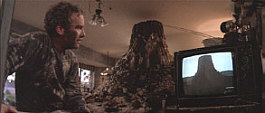 Is CE3K a flawless movie? No, it has its own problems at times. For example, I always thought the aggressive way in which the aliens came to get Barry seemed to be at odds with their apparently-gentle nature; the abduction makes sense within the tone of the movie because it adds excitement and intrigue, but it didn’t really seem logical to me.
Is CE3K a flawless movie? No, it has its own problems at times. For example, I always thought the aggressive way in which the aliens came to get Barry seemed to be at odds with their apparently-gentle nature; the abduction makes sense within the tone of the movie because it adds excitement and intrigue, but it didn’t really seem logical to me.
Nonetheless, the film functions at a consistently high level from start to finish and offers an extremely well-executed fantasy. The acting is top-notch from Dreyfuss down the line. Through movies like Jaws and The Goodbye Girl - another 1977 offering, and one for which he earned an Academy Award - Dreyfuss became moderately pigeonholed as a sarcastic, self-centered sort of character. CE3K showed that he could easily portray other roles, and he brings off the middle-class dreamer in Neary nicely.
Spielberg paced the film well, and though the effects have aged, they still hold up after almost a quarter of a century. It achieves a level of beauty and tenderness rare in the genre, and it also combines well-integrated humor, drama and action. As a whole, Close Encounters of the Third Kind remains a fabulous piece of work that deserves to be included along with the greatest films ever made.
|
The DVD Grades: Picture B+ / Audio B+ (DTS), B (Dolby Digital) / Bonus B+
|
|
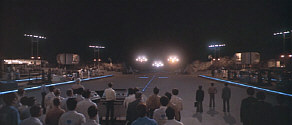 Close Encounters of the Third Kind appears in an aspect ratio of approximately 2.35:1 on this single-sided, dual-layered DVD; the image has been enhanced for 16X9 televisions. Because of the heavy special effects content of the film, it will always look less than perfect, as I’ll discuss. However, I thought that most of the movie appeared quite solid on this DVD, and it offered a largely satisfying picture.
Close Encounters of the Third Kind appears in an aspect ratio of approximately 2.35:1 on this single-sided, dual-layered DVD; the image has been enhanced for 16X9 televisions. Because of the heavy special effects content of the film, it will always look less than perfect, as I’ll discuss. However, I thought that most of the movie appeared quite solid on this DVD, and it offered a largely satisfying picture.
Sharpness usually seemed to be excellent. A few wide shots presented some very slight softness, and interiors could come across as a little fuzzy, but these instances were rare. As a whole, the movie appeared nicely accurate and detailed. Moiré effects cropped in a few scenes when I saw blinds, but they were slight, and I noticed no examples of jagged edges. Print flaws were very modest. During the entire film, I only detected a few examples of small speckles; nothing more significant appeared.
I should note that moderate grain could be seen throughout CE3K, but I don’t consider that a specific print flaw because it seemed clear that the grain always accompanied the film. As I mentioned earlier, CE3K featured an inordinate amount of special effects, and sometimes visual work showed up in unusual places; for example, most - if not all - nighttime sky shots used effects instead of natural material. As such, some grain came along with the added photographic elements. In addition, a few low-light scenes featured a little grain; the first meeting between Neary and Lacombe demonstrates this. While the grain could become a distraction, I couldn’t fault the transfer itself, as it was obvious these concerns always existed.
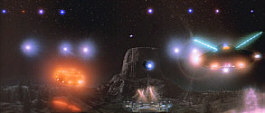 Colors looked quite natural and distinct. The film didn’t feature a particular bright palette except for the hues generated by the alien crafts themselves, and I felt these tones appeared clear and vivid. Black levels occasionally looked a little too pale, but they usually appeared appropriately deep and dense, and shadow detail seemed clean and nicely heavy without excessive opacity. Frankly, I wavered when I had to grade Close Encounters; I nearly gave it a “B”. However, I went with the higher rating because it generally looked great despite a few concerns. Much of the film appeared absolutely terrific, and those moments helped to compensate for some other issues.
Colors looked quite natural and distinct. The film didn’t feature a particular bright palette except for the hues generated by the alien crafts themselves, and I felt these tones appeared clear and vivid. Black levels occasionally looked a little too pale, but they usually appeared appropriately deep and dense, and shadow detail seemed clean and nicely heavy without excessive opacity. Frankly, I wavered when I had to grade Close Encounters; I nearly gave it a “B”. However, I went with the higher rating because it generally looked great despite a few concerns. Much of the film appeared absolutely terrific, and those moments helped to compensate for some other issues.
The soundtracks of Close Encounters also displayed some problems but they nonetheless worked quite well for a film of this vintage. In a first for a DVD from Columbia-Tristar, CE3K offers both Dolby Digital 5.1 and DTS 5.1 soundtracks; the studio released separate DD and DTS editions of Men In Black last year, but this is their first DVD to toss in both mixes. While those two tracks sounded nearly identical, I heard more of a difference during CE3K, and I clearly favored the DTS version.
As such, my comments about the movie’s soundtrack will solely address the DTS mix for the time being; a summary paragraph will then discuss the ways in which I felt the Dolby edition differed from it. The DTS track featured a surprisingly broad and engaging soundfield. The front speakers offered a nice sense of ambience; in addition to John Williams’ score, they added a great deal of unique effects, all of which seemed to be well placed within the environment. The elements also blended together neatly and smoothly. Some directional dialogue occurred, and while it could seem somewhat tentative at times, for the most part I felt that the speech appeared to come from the appropriate locations.
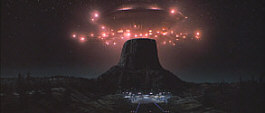 Surround usage generally sounded to be monaural, but a few instances of split-surround usage clearly appeared; for instance, during a few scenes when alien ships zoomed past us, the audio provided unique information for the left and right rear channels. Otherwise, I thought that the surrounds contributed very solid reinforcement for the track. They didn’t seem to present a great deal of sound that was clearly specific to them, but they strongly bolstered the atmosphere throughout the movie. From the opening desert sandstorm scene to the ending with the Mothership, the rear speakers were fairly active participants that made this soundtrack quite compelling.
Surround usage generally sounded to be monaural, but a few instances of split-surround usage clearly appeared; for instance, during a few scenes when alien ships zoomed past us, the audio provided unique information for the left and right rear channels. Otherwise, I thought that the surrounds contributed very solid reinforcement for the track. They didn’t seem to present a great deal of sound that was clearly specific to them, but they strongly bolstered the atmosphere throughout the movie. From the opening desert sandstorm scene to the ending with the Mothership, the rear speakers were fairly active participants that made this soundtrack quite compelling.
Audio quality was more erratic. Dialogue presented the most problems. While speech always seemed to be intelligible, I thought that some minor edginess affected the experience. Most lines appeared acceptably natural, but some came across as a bit brittle and rough. Effects also showed some thinness and lacked tremendously natural qualities, though they matched up fine with most audio of the era; without re-recorded stems, this was about as good as the effects were likely to sound. Happily, they boasted some tremendous low-end at times. When the plane engines fired up during the opening desert sequence, the subwoofer kicked in with solid bass, and quite a few other scenes contributed excellent depth as well; as Roy experienced his first “close encounter”, I thought the hum of the ship was going to crack my foundation!
John Williams’ score also presented nice dynamics, and the music appeared to be bright and vivid throughout the movie. Some hiss accompanied the track, and this defect seemed connected to the music; it only cropped up when the score became more prominent. However, the hiss was modest and didn’t create a terrible distraction. Frankly, I really liked the DTS soundtrack of CE3K; were it not for some of the edginess to speech and the thinness of the effects, it would have easily made it to “A” territory. As it stands, I felt it earned a solid “B+”.
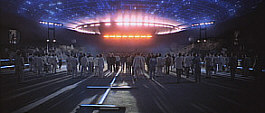 For the most part, the Dolby Digital 5.1 soundtrack echoed the DTS mix. However, I thought that it showed a few more problems. In general, the DD affair seemed to present more obvious distortion; both effects and speech could sound rather harsh at times, whereas they appeared a bit smoother during the DTS track. While the DD mix offered some nice bass, the depth and tightness of the low end didn’t seem to be as solid; it presented a nice rumble at times, but it failed to deliver the same level of specificity. Also, the soundfield itself didn’t come across with the same broad and encompassing atmosphere; it appeared a little more sterile. Ultimately, the Dolby Digital track still appeared to be quite good for the film’s era, but I know that when I watch Close Encounters in the future, I’ll always select the DTS mix.
For the most part, the Dolby Digital 5.1 soundtrack echoed the DTS mix. However, I thought that it showed a few more problems. In general, the DD affair seemed to present more obvious distortion; both effects and speech could sound rather harsh at times, whereas they appeared a bit smoother during the DTS track. While the DD mix offered some nice bass, the depth and tightness of the low end didn’t seem to be as solid; it presented a nice rumble at times, but it failed to deliver the same level of specificity. Also, the soundfield itself didn’t come across with the same broad and encompassing atmosphere; it appeared a little more sterile. Ultimately, the Dolby Digital track still appeared to be quite good for the film’s era, but I know that when I watch Close Encounters in the future, I’ll always select the DTS mix.
As a two-DVD special edition, one might expect some solid extras with Close Encounters of the Third Kind, and the package indeed includes some nice pieces. The vast majority of these appear on the second disc. In fact, the only non-film aspect of DVD One is the THX Optimode program. Another new addition to this DVD is the inclusion of the “THX Optimode” program. As also found on other DVDs like Supergirl and X-Files, this is supposed to be used to set up your home theater to best present the movie on the disc in question. Apparently the Optimode is unique for each DVD on which it’s included; unlike programs such as Video Essentials, the Optimode should tweak your set-up differently every time. Frankly, I’ve been very happy with my already-established calibration and I’m afraid to muck with it, so I’ve never tried the Optimode. If you lack calibration from Video Essentials or a similar program, or if you’re just more adventurous than I, the Optimode could be a helpful addition.
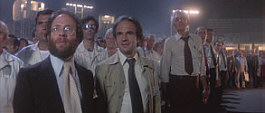 From there we move to DVD Two, where we’ll find the meat of the supplements. Most substantial of the bunch is a fine documentary about the movie. The piece lasts for 101 minutes and 30 seconds. Simply entitled “The Making of Close Encounters of the Third Kind”, this program combines film clips, excellent shots from the set, and a slew of fairly contemporary (circa 1997) interviews with participants. The latter aspect of the documentary packs in virtually all of the main players; in addition to writer/director Spielberg, we hear from actors Richard Dreyfuss, Melinda Dillon, Teri Garr, Bob Balaban, and Cary Guffey plus composer John Williams, director of photography Vilmos Zsigmond, editor Michael Kahn, production designer Joe Alves, animation supervisor Robert Swarthe, chief model maker Gregory Jein, production illustrator Ralph McQuarrie, special photographic effects person Douglas Trumbull, and Mothership photographer Dennis Muren. That’s a high-powered crew and their discussions added a lot of depth to my knowledge of the film.
From there we move to DVD Two, where we’ll find the meat of the supplements. Most substantial of the bunch is a fine documentary about the movie. The piece lasts for 101 minutes and 30 seconds. Simply entitled “The Making of Close Encounters of the Third Kind”, this program combines film clips, excellent shots from the set, and a slew of fairly contemporary (circa 1997) interviews with participants. The latter aspect of the documentary packs in virtually all of the main players; in addition to writer/director Spielberg, we hear from actors Richard Dreyfuss, Melinda Dillon, Teri Garr, Bob Balaban, and Cary Guffey plus composer John Williams, director of photography Vilmos Zsigmond, editor Michael Kahn, production designer Joe Alves, animation supervisor Robert Swarthe, chief model maker Gregory Jein, production illustrator Ralph McQuarrie, special photographic effects person Douglas Trumbull, and Mothership photographer Dennis Muren. That’s a high-powered crew and their discussions added a lot of depth to my knowledge of the film.
Not surprisingly, Spielberg dominates the proceedings. Filmed from the set of Saving Private Ryan, he contributes lots of solid details about the project’s genesis and its production, though at times I’m not terribly sure how well we can trust his memory. I also own the Criterion laserdisc CE3K set, and Spielberg alters some of the stories he told on that older set. None of the changes are major, but they exist; for example, when he discusses the ways in which he got little Cary Guffey to perform in the necessary manner, some of the details have changed. Nonetheless, the overall intent remained intact, so I don’t have too many concerns about Steve’s memory.
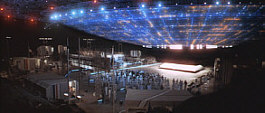 As for the rest of the crew, they chime in quite frequently and add a tremendous amount of solid information about the movie. It’s a fine mix of technical and creative, and the overall arc of the production is related in a succinct and entertaining manner. The many outtakes and behind the scenes shots are also delightful; I especially enjoyed the alien test footage images. Put simply, this was an outstanding documentary that should be thoroughly compelling for fans of the film.
As for the rest of the crew, they chime in quite frequently and add a tremendous amount of solid information about the movie. It’s a fine mix of technical and creative, and the overall arc of the production is related in a succinct and entertaining manner. The many outtakes and behind the scenes shots are also delightful; I especially enjoyed the alien test footage images. Put simply, this was an outstanding documentary that should be thoroughly compelling for fans of the film.
From a few different websites there have been reports that this documentary
included some new segments and/or was altered in various ways. However,
these statements are absolutely incorrect. I just synched up the two and
they were totally identical; not one bit of the original piece has been
changed, as the documentary completely duplicates the one found on the 1998
LD. Anyone who says otherwise is just speculating based on memory and they
are wrong.
“Watch the Skies” is a brief featurette that came out at the same time as CE3K itself. This is truly a promotional piece. While it includes some good behind the scenes shots from the set and tosses in a few interview snippets as well - such as an explanation from Spielberg, Dreyfuss and UFO expert J. Allen Hynek about the different forms of close encounters - it’s still little more than a five-minute and 45-second trailer. Nonetheless, I thought it was watchable and entertaining within those parameters.
Speaking of trailers, the DVD includes two. The original theatrical one is really just a slightly shorter version of “Watch the Skies”; it even still features the bit about the various types of close encounters. It provides more film clips and omits most of the other interviews, however, and it lasts for four minutes and 40 seconds. The second trailer was created for the 1980 special edition, so it’s totally different from the first promo; it clocks in at one minute and 45 seconds.
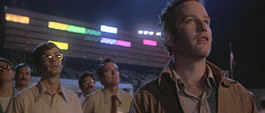 In the Deleted Scenes section we find a genuine treasure trove of footage. All in all, we get 11 segments that run for a total of 24 minutes, and most of them are quite interesting. Each clip lasts between 42 seconds and five and a half minutes. We see more of Neary immediately before and after his first close encounter, and some scenes between Lacombe and Laughlin are added as well. This domain provides the special edition shots from inside the Mothership. While I suppose that none of the material is truly earth-shattering, I really enjoyed all of it. For folks less enamored of CE3K, the footage may not be as much fun, but for those who love the flick - as I do - then this stuff should be absolutely terrific.
In the Deleted Scenes section we find a genuine treasure trove of footage. All in all, we get 11 segments that run for a total of 24 minutes, and most of them are quite interesting. Each clip lasts between 42 seconds and five and a half minutes. We see more of Neary immediately before and after his first close encounter, and some scenes between Lacombe and Laughlin are added as well. This domain provides the special edition shots from inside the Mothership. While I suppose that none of the material is truly earth-shattering, I really enjoyed all of it. For folks less enamored of CE3K, the footage may not be as much fun, but for those who love the flick - as I do - then this stuff should be absolutely terrific.
One oddity: the DVD doesn't include all of the material cut from the original release. The shot with Roy and the pillowcase fails to appear, as does the original introduction of the family. The Neary piece isn't very different from the version seen here, but the absence of the pillowcase scene is a shame. If Spielberg wants to omit them from the film as a whole, that's his prerogative, but we should still get them as supplements. At least we find the Carl Weathers bit and an extended edition of the excised power plant scene.
Lastly, the DVD includes Filmographies for writer/director Steven Spielberg plus actors Richard Dreyfuss, Melinda Dillon, Francois Truffaut, and Teri Garr. We also get some brief but decent production notes within the DVD’s case.
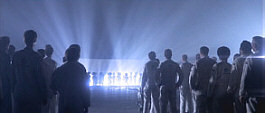 Speaking of which, I should mention that the two CE3K discs are housed in an unusual package. The case opens to the left like a “snapper” - the cover is also cardboard - but the discs don’t immediately appear. When you open the package, you’ll see the production notes in front of you and to your left. Lift the forward notes and you’ll discover the discs; one will move up and the other will appear in the slot beneath the production notes. All of this fits into a cardboard slipcase. It’s an odd choice, and not one I’d like to see too much in the future. I guess it’s not any worse than the average snapper, but I prefer normal two-disc keepcases; they’re much more practical and stable.
Speaking of which, I should mention that the two CE3K discs are housed in an unusual package. The case opens to the left like a “snapper” - the cover is also cardboard - but the discs don’t immediately appear. When you open the package, you’ll see the production notes in front of you and to your left. Lift the forward notes and you’ll discover the discs; one will move up and the other will appear in the slot beneath the production notes. All of this fits into a cardboard slipcase. It’s an odd choice, and not one I’d like to see too much in the future. I guess it’s not any worse than the average snapper, but I prefer normal two-disc keepcases; they’re much more practical and stable.
Although most of these extras came from the 1998 laserdisc boxed set, not all of that package’s supplements made it to the DVD. The older program added a very substantial still archive, which included storyboards, conceptual art, a slew of production photos, and a variety of promotional materials. Why are these not on the DVD? I have no idea; the disc included plenty of room for them, and they really should have made the cut.
While these omissions are disappointing, the DVD release of Close Encounters of the Third Kind is still a must-have. The movie itself remains a classic, as Spielberg tells an enchanting story of our first formal meeting with aliens. He utilizes a first-person point of view that makes the tale accessible and moving, and the entire project is fulfilled with beauty and style. The DVD shows some minor flaws, but picture and sound generally seemed to be quite positive. The extras are also solid, with the highlights coming from an excellent documentary and some terrific deleted scenes. Three years ago I dropped $80 on the laserdisc version of this set and never regretted it; with a list price of only $27.95, the DVD of Close Encounters is a steal and should definitely appear in your collection.
|
|
[an error occurred while processing this directive]
|
|

